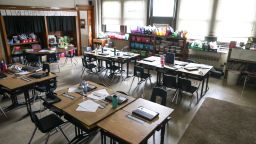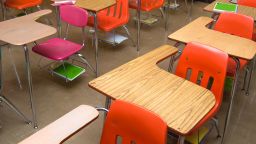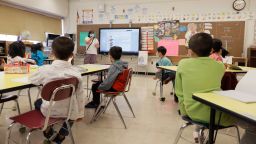After nearly three years of the pandemic, national test scores for students aren’t where educators hoped they would be — does that mean it’s time to break out the math and vocabulary drills?
Maybe not, experts say.
The National Center for Education Statistics, a branch of the US Department of Education, gives an exam every year to fourth and eighth graders in math and reading, which is often called the “Nation’s Report Card.” This year’s assessment showed students fell behind in reading and had the largest decline ever in math, according to the results.
The drop may be concerning, but it’s not surprising given the large disruption to learning over the course of the first two years of the pandemic, said Doug Clements, distinguished professor and chair in the department of early childhood learning at the University of Denver.
“This should be seen as a testament to what teachers do in regular circumstances,” said Julie Sarama, professor and chair in the department of innovative learning technologies at the University of Denver. “We all found out how valuable teachers are.”
Students who are behind where they are expected to be academically now won’t necessarily stay there, said Clements, who is also co-executive director of the University of Denver’s Marsico Institute for Early Learning. However, it will take energy and effort on the parts of policymakers, educators, students and their families, he said.
But before you start printing out worksheets to run math drills with your child, Dr. Elizabeth Albro encourages families to pause and remember that these large-scale tests aren’t the biggest predictors of future success.
“The challenge with predictors is they’re only one piece of the puzzle,” said Albro, commissioner of the National Center for Education Research.
Instead of focusing on just the details of curriculum your student might have missed out on, experts are encouraging parents to look at how to support their children to become successful.
What a first grader needs to catch up is going to be different than what a ninth grader needs, Albro said, but focusing on these strategies — rather than the curriculum or homework — can help set them up to overcome learning obstacles at any stage.
Learn together
Modeling by bringing learning into the family is a great way to teach the skills that kids need, Clements said.
Clements recommended telling your kids stories from when you struggled with something and asked for help or got stuck with a problem you didn’t know how to solve. Those skills may not be the material they are tested on, but knowing how to get support and bounce back from difficulties makes for strong learners who are better equipped to master their curriculum, he said.
Especially in the earlier years of education, reading with your children is considered high-quality support, Albro said.
It doesn’t have to be rigid to be effective, Clements said. Just getting small kids in pajamas to read stories they are excited about or older ones seeing their family get involved in math and literature together can help students and families become invested in learning, said Yvonne Johnson, president-elect of the National PTA.
Play together
There is a time and place for multiplication drills, Clements said — but combining fun and learning is key to raising good learners.
Feeling positive about and invested in learning is an important place to start, Clements said. Whether you have a fourth or eighth grader, he recommended games to build thinking skills, confidence in children’s abilities and their working memory.
For younger kids, that can mean playing “follow me” games in the car — think of the number five, double it, add two and subtract seven — and compare answers among kids. Or adapt card games such as go fish or war so kids aren’t just looking for a higher or matching number, but one that solves their math problems, Clements and Sarama said.
For older kids, pose problems that they can get excited about in everyday life — and encourage them to see these through until they find solutions, Clements said.
Check on their mental health
If you want kids to do well in school, make their whole well-being a priority, Johnson said.
“The overall health of a child — they have to eat, they have to have a healthy mind, and they have to feel safe — that’s how they do well in school,” she said.
The pandemic and its disruptions to education have been stressful for everyone, Albro said.
“In many ways, one of the most important things I think that we’ve learned is that social connection is one of the critical functions that in-person school plays,” she added.
For students to get back on track with reading and math, a sense of security and social connection needs to be reestablished on campus, Johnson said.
“Take a breath, spend some time together, listen to your kid, talk to your teacher,” Albro said.
Be a team with their educators
One benefit of such assessments is that parents and caregivers can help teachers understand students’ strengths and weaknesses, and families can then work together to develop a plan to grow, Albro said.
The closer a relationship between a family and school, the better understanding the adults can get into how to help their student. If there is open dialogue between them, families and teachers can share what they see in terms of a child’s academic and emotional well-being so that each has a fuller picture, Johnson said.
Many schools are working to catch students up after remote learning, she added.
“If families don’t know that these supports are in place for these students, then they can’t help them,” Johnson said.
Try to get involved and go into the school if possible, Clements said. He recommends calling or writing to teachers to ask how to help children develop.
Educators’ first response might be to send a worksheet home since that is often what makes families more confident a child is learning. But Clements encourages adults to push for advice on helping children practice the material and learning skills together.
“Families need to feel comfortable having those conversations with educators,” Johnson said. “It’s not really about the scores. (It’s) how do we improve students’ outcomes.”
Sign up for CNN’s Stress, But Less newsletter. Our six-part mindfulness guide will inform and inspire you to reduce stress while learning how to harness it.










